My name is Vicki O’Brien and I am the maths subject leader at Therfield First School – a small, village school. There are 52 children from Reception to Year 4 in mixed-age classes and I have been teaching here for 8 years. Teaching in a small school has many benefits – we know our children and their families really well and there is a real sense of community. In class, we are able to target our teaching based on our understanding of each child’s starting point in each concept as we move through the year. However, with maths teaching, our mixed year group classes do present a challenge for us. Firstly, because of the specific curriculum requirements for each year group and secondly, the varied individual starting points for children. But one thing I know about our school is that we always rise to a challenge.
Last academic year, I engaged with Herts for Learning and the Matrix Maths Hub in the NCETM Mastery Readiness programme and this journey to develop mastery teaching across the school continues for us this year. As a school, we have always been passionate about growth mindset but for some of our children, maths is a subject that has historically caused a level of anxiety for a variety of reasons.
I wanted to write this blog to share how considering our school vision for maths and implementing fluency sessions has led to my class becoming confident mathematicians who enjoy exploring, sharing and bouncing ideas off of each other and how I manage this logistically in a mixed-age class.
Why did I decide to add fluency sessions to our timetable?
We have tried a number of mixed-age planning materials and have now found one that works for our school in terms of concept mapping. However, having used these materials for the past 3 years, we felt that there were gaps in the teaching plans in terms of developing fluency and arithmetic proficiency. This is something that we explored through the Mastery Readiness programme and I felt that this was an area we could develop further.
The children were not always making connections between what they already knew and new learning, the steps were sometimes not small enough for all children to secure understanding and I felt there needed to be more time for practice. This was having a particular impact in our mixed age classes because it felt like we were going from one thing to another and it felt rushed.
In addition, we also felt that the materials we were using to flash back to prior learning weren’t enabling development of language or providing a low-threshold, high ceiling approach. The materials were designed for specific year groups, the questions were quite closed and didn’t explicitly involve giving any explanation beyond the ‘answer’. The children weren’t excited about them.
When we returned from the national lockdown in spring 2021, we needed something that would be accessible for all to help us find and fill any gaps as quickly as possible to allow teaching of the maths curriculum to continue with understanding. The children had engaged well with home learning but when back in class, were finding it difficult to articulate their thinking or express how they had worked things out. So in April 2021, we purchased the Herts for Learning fluency slides and have been using these in Key Stage 1 and Lower Key Stage 2 since Easter.
The launch
Just after the Easter break, I led an INSET for teachers and TAs to explore how use of these materials could benefit our children. We considered our shared vision and culture around the importance of maths and our belief that every child can achieve. We looked at our timetables to ensure that we could give this proper time to support the development of mathematical fluency.
What I did and what I’ve noticed
As I said, I started using the fluency materials with my Year 3 & 4 class in spring. I chose to do 3 slides that I felt could be used to explore both Year 3 and 4 content. My main aim was to get children to be confident and vocal about what they were learning – talking, proving and investigating.
In my class, I have children working at Y2, Y3 and Y4 level with some who could make links beyond that. To start with, I took something they had already learned to develop confidence with the structure of the sessions and so everyone felt comfortable to participate.
Over time, we explored the 3 concepts at great depth and made connections to things they had learned this year (and in previous years) using sentence structures such as, “If I know ‘this’ then I know ‘that’”. I noticed how engaged they all were – including those who have previously been reluctant to contribute to whole class discussion.
Multiplicative fact recall and reasoning
When we first started, the children had manipulatives on their tables to build arrays. I showed them one on the Interactive Whiteboard and they built it themselves with double sided counters and explored it using the language I provided.
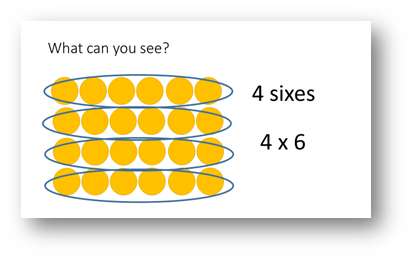
For each array, children talked to each other about what they noticed and I modelled to them how we would describe it in full sentences, e.g. I can see 4 sixes. This is 4 times 6. The children then repeated this back, also in full sentences to support the language development.
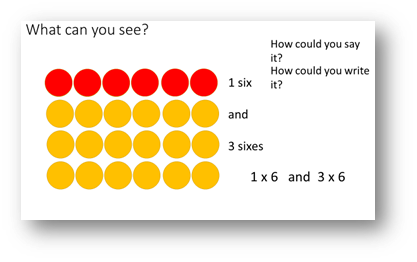
For this array, the children flipped over the top row of their double sided counters. The overall array hadn’t changed but now we were describing the equal parts differently. We talked about ‘what’s the same?’ and ‘what’s different?’
Everybody has the manipulatives. The children don’t perceive others as ‘better’ or ‘worse’ at maths than them. This approach proved valuable for those ‘fast finishers’ as they were having to model and explain using accurate language. For all children, their multiplicative understanding was deepening.
Over time, they were able to consider how they would split arrays to make calculation easier. This depended on each child’s known facts. For example, the example below shows 6 sevens split into 3 sevens and 3 sevens. For some of my children, this helped with calculating. But for some who were not yet confident with their 3 x table, it was easier for them to split it into 5 sevens and 1 seven, allowing them to use a fact from their 5x table and then add on one more group of 7. This was allowed… and encouraged!
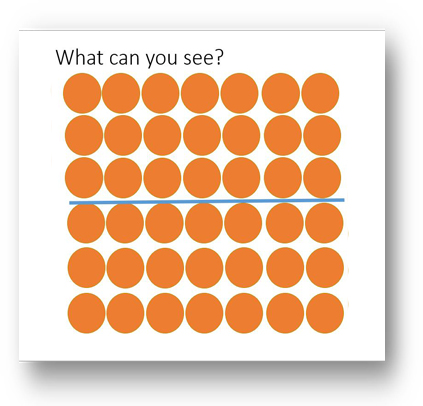
After four weeks of manipulating arrays and having these conversations, the children were increasing in confidence at working out unknown products and were thinking much more flexibly. We then continued without the manipulatives with larger numbers.
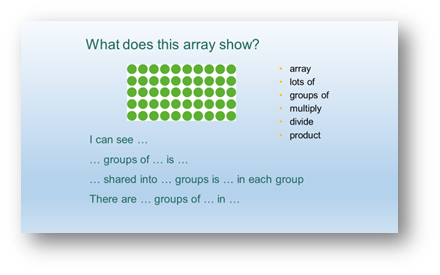
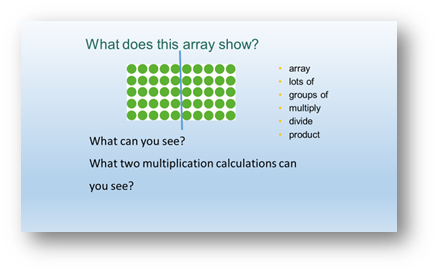
They were now starting to consider benchmarks more naturally and consider numbers that were easy to multiply. So below, spotting that they could calculate 10 x 7 + 5 x 7 to find the overall number of dots.
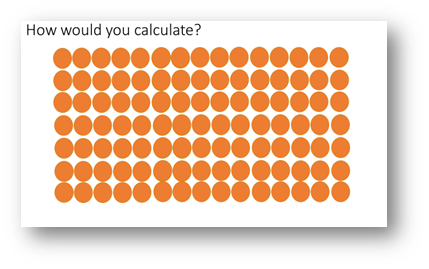
Geometry
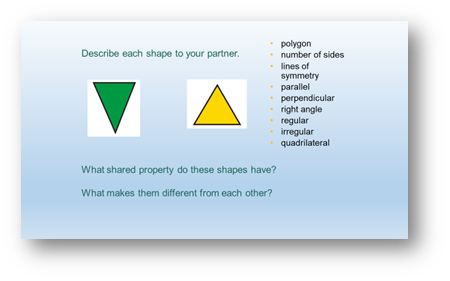
The second concept we have focused on is geometry – properties of shape. For my mixed-age class, this was perfect to get some rich discussion going, developing accurate mathematical language at the same time. All children are able to contribute and over time, their knowledge became more secure and they are much more able to describe what they notice.
The focus might be on triangles one week and then quadrilaterals the next. Each day, it’s very similar… but different. This keeps the children thinking but allows them to continue to make connections each time and build up what they know.
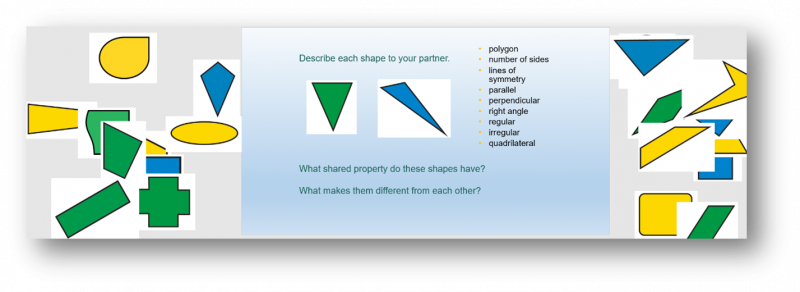
I keep a bank of images to choose from to adapt the slides each time so it doesn’t take long to change it up to build upon the previous day. Having the language down the sides takes the stress away from the teacher and it’s there for everybody to use – adults included!
Place value… and more
When we first started a place value slide, it would just involve talking about the simple place value – thousands, hundreds, tens and ones. Now we talk about greater than / less than, patterns, rounding, doubling, halving, odd, even… Before I even say it, the children are adding or subtracting the numbers automatically. They are not constricted but allowed time to explore.
Sometimes we discuss a number as a whole class, bouncing ideas off of each other. Other times, children work in pairs to record their thoughts and to link the number to other areas of maths. If I notice an error or potential misconception, we can talk about it there and then in the session.
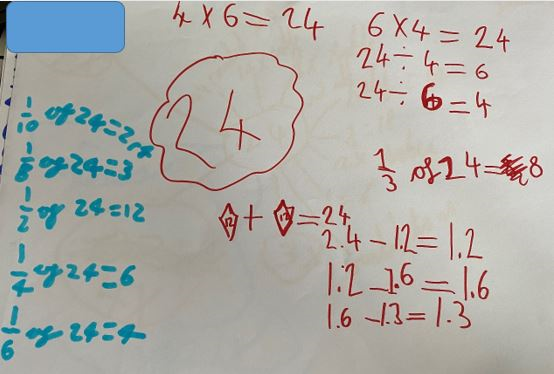
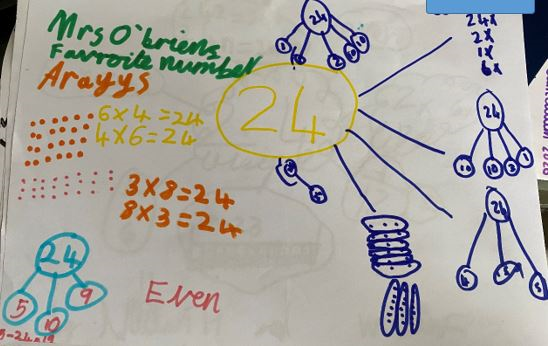
The children are growing in confidence to try things out and then share them with the class. It doesn’t matter whether they are in Year 3 or Year 4, they are bringing their ideas together and they have no fear of failing as it’s all a discussion. They pick up on things I hadn’t even thought about. When we learn something new in class, they bring this to the table too. So for example, after we had learned about measurement, they began making connections to the place value and thinking about how the numbers would be affected by multiplying or dividing by powers of 10.
Headteacher, Tara McGovern, says of these fluency sessions, “Children suddenly immersed themselves in the maths and were proud about what they know. They were exploring numbers, bringing what they knew to the table. We have found previously that children have stated that they find maths hard or said they can’t do it. They’ve put themselves in a box. But in these sessions, the children are enthusiastic and the collaboration between the children is a joy to see.
In one session for example, the children were talking about related facts. One child explained what would be ten times greater. Another child then suggested an inverse operation and it ping ponged around the class, accelerating from something that could have been simple fact recall.
These short bursts of fluency are buzzy sessions that move across the curriculum. Participation is high for all children and they are developing more independence and stamina as time goes on.
Confidence has been brought back into the classroom for the upcoming maths lessons and children are recognising themselves as mathematicians.”
As the class teacher, in the first half term, I noticed a big difference in what the children could do. Fluency slides have given the children a voice. Even those who may struggle in maths lessons can share what they know and learn from others.
Blog authored by Vicki O’Brien, Therfield First School, Hertfordshire.
Professional development opportunity
Join us for face-to-face training at the Hertfordshire Development Centre to:
• consider the rationale for developing fluency sessions. Why do pupils need to be ‘fluent’ in maths and what do they need to be fluent with?
• explore possible structures and ways of organising sessions
• consider the appropriate content for fluency sessions, including what is appropriate for the year group and time in the academic year
• take away resources for a staff meeting to use with staff and a full set of (revised and updated) fluency session materials to use and adapt with each year group


